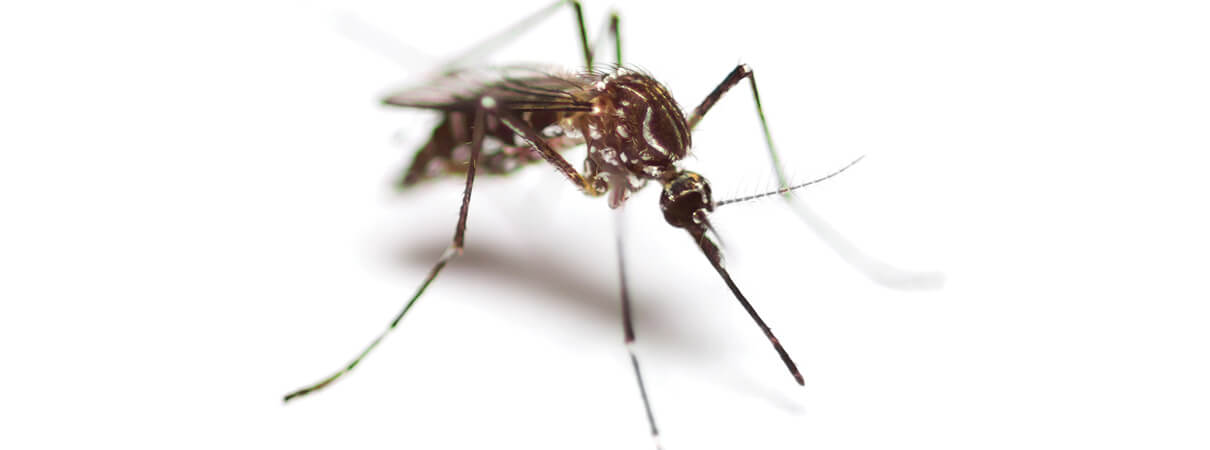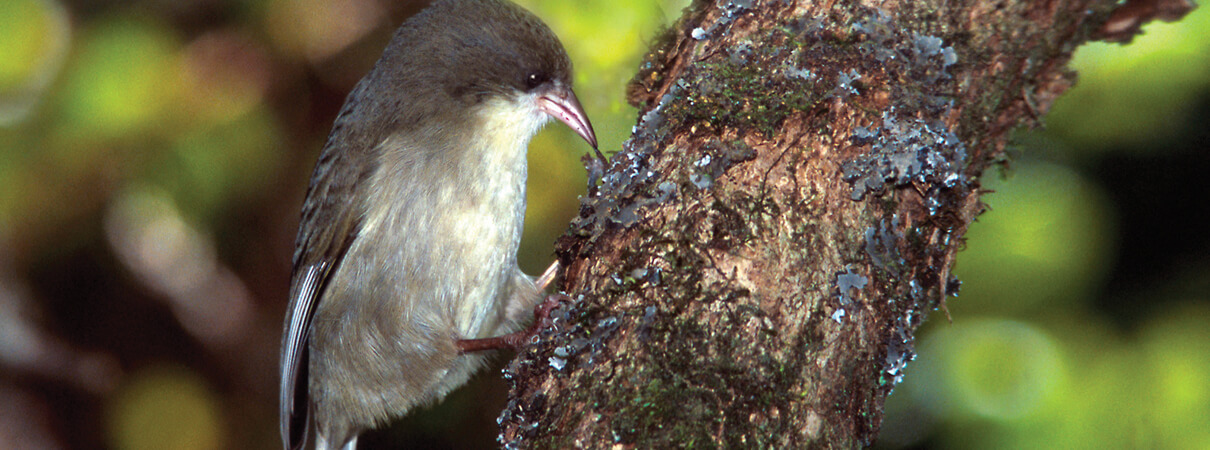Can Biotechnology Stop Hawai'i's Invasive Mosquitoes?
One of the biggest threats to Hawai‘i's native forest birds is also one of the tiniest. Non-native mosquitoes that spread two deadly diseases, avian malaria and avian pox, have infiltrated the main islands. The diseases, like the mosquitoes, are also non-native, and they're decimating native bird populations already stressed by habitat loss and other introduced plants and animals.

Hawai'i has no native species of mosquitoes, but several species have been accidentally introduced by humans. Photo by Isara Kaenla / Shutterstock
The threat is becoming even more dangerous for Hawai‘i's birds. For many species, global climate change is projected to increase the transmission risk as mosquitoes — and the malaria parasite — are able to survive at ever higher altitudes. A wave of extinctions could follow.
Recent advances in biotechnology could prevent this epidemic. Several techniques now exist to modify, suppress, or even eliminate mosquito populations to preclude the spread of avian diseases. Some of these approaches, including the introduction of sterile male mosquitoes and a bacteria that disrupts the reproduction of mosquitoes and pathogens, have been tested successfully and safely elsewhere. Other more controversial techniques, notably so-called gene drives, are still in the developmental stages.
None of these techniques have been shown to directly affect human health. And removing the mosquitoes could help to restore the islands' natural state of affairs. These unwelcome insects “are not a natural part of the Hawaiian food web. No native species depends on them,” says Chris Farmer, ABC's Hawai‘i Program Director.
Still, manipulating nature can have unintended consequences, and conservationists are approaching the matter with care. When, where, and if any of these techniques are deployed to save Hawai‘i's birds depends not just on the state of the science, but on appropriate oversight — and, most critically, on making sure that Hawai‘i's human population supports such an intervention to save the islands' birds.
Invasive Mosquitoes: Carriers of Disease
Hawai‘i has no native species of mosquitoes. The insect invaders began arriving by ship in the 19th century, carried as larval stowaways in vessels' water supplies. Two species of mosquito, Aedes aegypti and Aedes albopictus, are the chief vectors for diseases that affect humans, including malaria, chikunguya, dengue fever, and Zika, which raised alarms around the world in 2016. Hawai‘i's Big Island suffered an outbreak of dengue fever in 2016 that sickened more than 260 people.

Non-native mosquitoes, such as the one pictured here on an Apapane, carry diseases that are deadly for Hawai'i's birds. Photo by Jack Jeffrey.
For birds, a different species of mosquito, Culex quinquefasciatus, is the one to worry about. The insects don't have to penetrate feathers; they aim for the skin of the legs or around the eyes. When they bite, infected mosquitoes transmit the avian pox virus or the parasite that causes avian malaria.
The consequences for the victims are ugly and often fatal. A bird infected with pox can develop large tumors on its legs and eyes and around its bill—“anywhere there's exposed skin,” Farmer says. “Birds can just get so many tumors that they die.”
Avian malaria, though less gruesome, is no less dire. It ruptures red blood cells, causes internal organs to swell, and infected birds become lethargic and often die from fever. If they survive, they can suffer lasting effects that make it harder for them to reproduce and live out full lifespans.
Mosquitoes Are Decimating Hawai‘i's Forest Birds
By the late 1800s, as the Culex mosquitoes spread, avian pox had taken hold among the islands' bird populations, contributing to a rash of extinctions around 1890. By the early 1900s, avian malaria had begun to take a noticeable toll as well, leading to many extinctions in the first half of the century and limiting the range of most remaining bird species to elevations above 4,500 feet.

Native Hawaiian birds find refuge from mosquitoes in the montane forests of Kaua‘i's Alaka‘i Swamp, which has a climate that is unsuitable for mosquitoes. This refuge and others like it are now in peril due to climate change — as the slopes warm, mosquitoes are able to survive at higher and higher elevations. Photo by Jack Jeffrey
Native honeycreepers such as critically endangered ‘Akikiki, ‘Akeke‘e, and the more widespread ‘I‘iwi are currently the biggest losers. The first two species are already on the brink of extinction — each has fewer than 1,000 individuals remaining — and increasing exposure to diseases could push them over the edge. As climate change increases temperatures and alters rainfall patterns, the mosquitoes are spreading upslope. Some population and habitat-change models suggest that without fast conservation action, many species could be wiped out as soon as 2020.
Kaua‘i, with its lower elevations, has been especially hard hit. “Most of Kaua‘i's endemic birds are crashing pretty hard,” says Farmer, with some species suffering population declines of more than 90 percent in recent years.
Too many have already vanished. Only 17 species of native forest honeycreeper remain, down from 39, according to Joshua Fisher, an invasive species biologist with the U.S. Fish & Wildlife Service. Avian malaria is one of the main culprits. “Our birds have been dealing with this for decades, and we're in critical numbers now,” Fisher says. The remaining birds have been restricted to higher-elevation stands of forest that remain mosquito-free. But as temperatures warm and rainfall patterns change, mosquitoes will invade those refuges as well.
Fisher coordinates an avian malaria working group in Hawai‘i that has brought together scientists and conservationists from federal and state agencies, universities, and NGOs, including ABC. Their goal: to assess an array of different biotech solutions that could resolve this crisis and provide more habitat for the birds — if the science and public opinion agree.
End of the Line for Some Mosquitoes?
The simplest way to reduce or eliminate mosquitoes is to make sure they don't reproduce. Under an approach called Sterile Insect Technique (SIT), for instance, sterilized male insects are released into the wild in large numbers. Female mosquitoes, overwhelmed by the influx of sterile males, are unable to produce offspring. Release enough sterile insects, and the population crashes.
SIT, which doesn't affect other species or the environment, has been around for decades. It has a record of success in the United States and beyond, having been used effectively for more than 40 years against agricultural pests in California, Florida, and other states, and to eradicate screwworm from the U.S. and Central America.

Honeycreepers, such as the 'Akikiki, are among the most vulnerable to mosquitoes. Photo by Jack Jeffrey
Kenneth Kaneshiro is Director of the Center for Conservation Research and Training at the University of Hawai‘i at Manoa. He was central to a SIT program in Japan, where the technique succeeded in ridding the Okinawa archipelago of two non-native species of fruit fly with no damage to public health or the native ecosystem. In September 2016, during the IUCN World Conservation Congress in Hawai‘i, Kaneshiro convened a two-day workshop to discuss the feasibility of a mosquito-free Hawai‘i.
Everybody involved in these ongoing conversations agrees on one thing: Public approval is critical before biotech can be brought to bear on Hawai‘i's mosquitoes. “We need to be sure that the general public will accept any mosquito eradication program that's adopted in the Hawaiian Islands,” Kaneshiro says.
A group called Revive & Restore, which promotes the “genetic rescue” of endangered or extinct species, has been active in these discussions. Ryan Phelan is Revive & Restore's Co-founder and Executive Director. Among the techniques she believes “could be really effective at knocking down mosquito populations even in remote areas” is a naturally occurring bacterium called Wolbachia. This parasite can affect mosquitoes in a variety of ways, including female sterility and a reduced ability to transmit agents of disease.
Wolbachia has been used for some time in agriculture as a sort of natural pesticide against a range of insects, and some people find it an attractive solution because it does not require genetic manipulation. Using it in Hawai‘i, she says, might “give the birds a chance.”
Genetic Interventions May Help Control or Eliminate Mosquitoes
Many conservationists also have high hopes for a technique that involves mosquitoes genetically edited to be unable to breed successfully. It's a type of modified SIT: release enough of the altered insects, and mosquito populations plummet. A firm called Oxitec has pioneered this approach in Brazil and elsewhere against dengue and Zika, with Florida next on the list. That work doesn't involve the Culex mosquito — yet — but the technique could be applied to that species for the benefit of birds.
A completely different approach that has grabbed headlines lately is so-called gene drive technology. It involves altering an organism's genome in order to “drive” a trait through a population. For instance, Culex mosquitoes could be modified in order to derail their ability to breed. Although many researchers are at work on gene drive techniques, they are controversial and many years away from being field-ready. The National Academy of Sciences, among others, has made it clear that policy and regulatory safeguards have to catch up with the science before the techniques leave the lab.
In the meantime, Hawai‘i's birds could still benefit from the enormous efforts being made to reduce mosquito-borne threats to humans. “All this energy, all this momentum, all this funding is going into eliminating the mosquito as a vector,” Phelan says. “Conservation has a unique opportunity right now to capitalize on the investment being made in human health.”

The ‘I'iwi is one of several Hawaiian honeycreeper species that are vulnerable to mosquito-borne diseases. Photo by Robby Kohley
Whatever the decision, it needs to be made soon. “The window is definitely closing on these birds,” says ABC's Farmer. “We don't have a ton of time. Doing nothing — whether through indecision, lack of awareness, or any other reason — will lead to further extinctions.”
ABC hasn't endorsed any one approach but is staying abreast of the science and is actively involved in the discussions. “Some of these techniques are controversial, but the technologies are so different from one another that it's like comparing a paper plane to a jet engine,” says Mike Parr, ABC's Chief Conservation Officer. “You don't throw them all out just because one is especially contentious.”
Regardless, Parr says, it's critical that the public has every chance to weigh in on the policy- and decision-making. “This is a community decision, and not something a single organization or agency can decide.”
If invasive mosquitoes were safely controlled or eliminated, the benefits to Hawai‘i's birds would be immense. Species now confined to small patches of mountain habitat could expand their ranges again if lower elevations were mosquito-free. “The birds we have left are the most robust species,” ABC's Farmer says. “They survived this long. And if we give them a little bit of help, they can survive for future generations.”
 Jennifer Howard is Director of Public Relations at ABC. She was a writer and reporter with The Chronicle of Higher Education for 10 years and before that was a contributing editor and columnist with The Washington Post. She writes nonfiction for The Times Literary Supplement and the Boston Review and her fiction work has been published by Virginia Quarterly Review and others. Follow Jen on Twitter at @JenHoward.
Jennifer Howard is Director of Public Relations at ABC. She was a writer and reporter with The Chronicle of Higher Education for 10 years and before that was a contributing editor and columnist with The Washington Post. She writes nonfiction for The Times Literary Supplement and the Boston Review and her fiction work has been published by Virginia Quarterly Review and others. Follow Jen on Twitter at @JenHoward.


















































